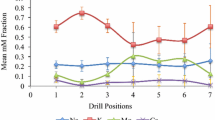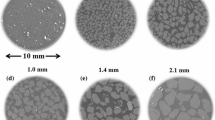Abstract
Salt weathering is a crucial process that brings about a change in stone, from the scale of landscapes to stone outcrops and natural building stone façades. It is acknowledged that salt weathering is controlled by fluctuations in temperature and moisture, where repeated oscillations in these parameters can cause re-crystallisation, hydration/de-hydration of salts, bringing about stone surface loss in the form of, for example, granular disaggregation, scaling, and multiple flaking. However, this ‘traditional’ view of how salt weathering proceeds may need to be re-evaluated in the light of current and future climatic trends. Indeed, there is considerable scope for the investigation of consequences of climate change on geomorphological processes in general. Building on contemporary research on the ‘deep wetting’ of natural building stones, it is proposed that (as stone may be wetter for longer), ion diffusion may become a more prominent mechanism for the mixing of molecular constituents, and a shift in focus from physical damage to chemical change is suggested. Data from ion diffusion cell experiments are presented for three different sandstone types, demonstrating that salts may diffuse through porous stone relatively rapidly (in comparison to, for example, dense concrete). Pore water from stones undergoing diffusion experiments was extracted and analysed. Factors controlling ion diffusion relating to ‘time of wetness’ within stones are discussed, (continued saturation, connectivity of pores, mineralogy, behaviour of salts, sedimentary structure), and potential changes in system dynamics as a result of climate change are addressed. System inputs may change in terms of increased moisture input, translating into a greater depth of wetting front. Salts are likely to be ‘stored’ differently in stones, with salt being in solution for longer periods (during prolonged winter wetness). This has myriad implications in terms of the movement of ions by diffusion and the potential for chemical change in the stone (especially in more mobile constituents), leading to a weakening of the stone matrix/grain boundary cementing. The ‘output’ may be mobilisation and precipitation of elements leading to, for example, uneven cementing in the stone. This reduced strength of the stone, or compromised ability of the stone to absorb stress, is likely to make crystallisation a more efficacious mechanism of decay when it does occur. Thus, a delay in the onset of crystallisation while stonework is wet does not preclude exaggerated or accelerated material loss when it finally happens.





Similar content being viewed by others
References
Brimblecombe P, Grossi CM (2007) Damage to Buildings from Future Climate and Pollution. American Preservation Technology Bulletin 38:13–19
Chorley RJ, Kennedy BA (1971) Physical Geography: A systems approach. Prentice Hall International Inc., London
Church M (2010) The trajectory of geomorphology. Prog Phys Geogr 34:265–286
Crawford T, Betts NL, Favis-Mortlock D (2007) GCM grid-box choice and predictor selection associated with statistical downscaling of daily precipitation over Northern Ireland. Climate Research 34:145–160
Cutler N, Viles HA (2010) Eukaryotic microorganisms and stone biodeterioration. Geomicrobiol J 27(6):630–646
Doehne E (2002) Salt weathering: a selective review. In Seigesmund S, Weiss T, Vollbrecht A (eds) Natural Stone, Weathering Phenomenon, Conservation Strategies and Case Studies. Geological Society, London, Special Publications 205, pp 51-64
Dove PM (1999) The dissolution kinetics of quartz in aqueous mixed cation solutions. Geochim Cosmochim Acta 63:3715–3727
Eugster HP (1967) Hydrous sodium silicates from Lake Magadi, Kenya: precursors to bedded chert. Science 157:1177–1180
Eugster HP (1969) Inorganic bedded cherts from the Magadi area, Kenya. Contrib Miner Petrol 22:1–31
Geiger R (1965) The Climate Near the Ground. Harvard University Press, Massachusetts, 4th Edition
Gorbushina A (2007) Life on the rocks. Environ Microbiol 9(7):1613–1631
Goudie AS (1997) Weathering processes. In: Thomas DSG (ed) Arid Zone Geomorphology, 2nd edn. Wiley, Chichester, pp 25–39
Gregory KJ (2010) The Earth’s Land Surface. SAGE Publications Ltd., London
Grossi CM, Brimblecombe P (2007) Effect of long-term changes in air pollution and climate on the decay and blackening of European stone buildings. In: Prikryl R, Smith BJ (eds) Building Stone Decay: From Diagnosis to Conservation. Geological Society, London, Special Publications 271, pp 117–130
Hager J (1998) Steam Drying of Porous Media, Ph.D. Thesis, Department of Chemical Engineering, Lund University, Sweden
Hall K (2009) Rock art vs cultural stone: some geomorphological perspectives on weathering and conservation under a changing climate. S Afr Geogr J 91:58–62
Hall K, Andre M-F (2001) New insights into rock weathering from high–frequency rock temperature data: an Antarctic study of weathering by thermal stress. Geomorphology 41:23–35
Hall C, Hoff WD (2012) Water transport in brick, stone and concrete. Spon Press, Oxon
Huinink HP, Pel L, Kopinga K (2004) Simulating the growth of tafoni. Earth Surf Proc Land 29:1225–1233
Iveson SM, Holt S, Biggs S (2004) Advancing contact angle of iron ores as a function of their hematite and goethite content: implications for pelletising and sintering. Int J Miner Process 74:281–287
Jenkins KA, Smith BJ (1990) Daytime rock surface temperature variability and its implications for mechanical rock weathering: tenerife, Canary Islands. Catena 17:449–459
Katz AJ, Thompson AH (1986) A quantitative prediction of permeability in porous rock. Phys. Rev. B. 34:8179–8181
McAlister JJ, Smith BJ, Curran JM (2003) The use of sequential extraction to examine iron and trace metal mobilisation and the case-hardening of building sandstone: a preliminary investigation. Microchem J 74:5–18
McAllister D, McCabe S, Srinivasan S, Smith BJ, Warke PA (2011) Moisture dynamics in building sandstone: monitoring strategies and implications for transport and accumulation of salts. In: Ioannou I., Theodoridou M (eds) Salt Weathering on Buildings and Stone Sculptures 2011, University of Cyprus, pp 39-46
McCabe S, Smith BJ, Warke PA (2006) Calcium loading of building sandstones by lime rendering: implications for decay. In: Fort R, Alvarez de Buergo M, Gomez-Heras M, Vazquez-Calvo C (eds.) Heritage, Weathering and Conservation. Taylor & Francis Group, London, pp 177–182
McCabe S, McKinley JM, Gomez-Heras M, Smith BJ (2011a) Dynamical instability in surface permeability characteristics of building sandstone in response to salt accumulation over time. Geomorphology 130:65–75
McCabe S, Smith BJ, McAlister JJ, McAllister D, Srinivasan S, Basheer PAM, Curran JM (2011) Linking climate change, moisture dynamics and salt movement within natural building sandstones: implications for salt transport by diffusion. In: Ioannou I., Theodoridou M (eds) Salt Weathering on Buildings and Stone Sculptures 2011, University of Cyprus, pp 63–70
Nespereira J, Blanco JA, Yenes M, Pereira D (2010) Irregular silica cementation in sandstones and its implication on the usability as building stone. Eng Geol 115:167–174
Oliver A (1988) Dampness in Buildings. BSP Professional Books, Oxford
Poupeleer AS, Carmeliet J, Roels S, Van Gemert D (2003) Validation of the salt diffusion coefficient in porous materials. International Journal for Restoration of Buildings and Monuments 9:663–682
Rodriguez-Navarro C, Doehne E (1999) Salt weathering: influence of evaporation rate, supersaturation and crystallization pattern. Earth Surf Proc Land 24:191–209
Schumm SA (1979) Geomorphic thresholds: the concept and its applications. Transactions of the Institute of British Geographers, New Series 4(4):485–515
Smith BJ (2009) Weathering processes and forms. In: Parsons AJ, Abrahams AD (eds) Geomorphology of Desert Environments (2nd ed), Springer Science + Business Media B. V., pp 69–100
Smith BJ, McGreevy JP (1988) Contour scaling of a sandstone by salt weathering under hot desert conditions. Earth Surf Proc Land 13:697–705
Smith BJ, Warke PA (1997) Controls and uncertainties in the weathering environment. In: Thomas DSG (ed) Arid Zone Geomorphology, 2nd edn. Wiley, Chichester, pp 41–54
Smith BJ, Turkington AV, Warke PA, Basheer PAM, McAlister JJ, Meneely J, Curran JM (2002) Modelling the rapid retreat of building sandstones: a case study from a polluted maritime environment. In: Seigesmund S, Weiss T, Vollbrecht A (eds) Natural Stone, Weathering Phenomenon, Conservation Strategies and Case Studies. Geological Society, London, Special Publications 205, pp 347–362
Smith BJ, Warke PA, Curran JM (2004) Implications of climate change and increased ‘time-of-wetness’ for the soiling and decay of sandstone structures in Belfast, Northern Ireland. In: Prikryl R (ed) Dimension Stone. Taylor & Francis Group, London, pp 9–14
Smith BJ, Gomez-Heras M, McCabe S (2008) Understanding the decay of stone-built cultural heritage. Prog Phys Geogr 32:439–461
Smith BJ, McCabe S, McAllister D, Adamson C, Viles HA, Curran JM (2011a) A commentary on climate change, stone decay dynamics and the ‘greening’ of natural stone buildings: new perspectives on ‘deep wetting’. Environmental Earth Sciences 63:1691–1700
Smith BJ, Srinivasan S, Gomez-Heras M, Basheer PAM, Viles HA (2011b) Near-surface temperature cycling of stone and its implications for scales of surface deterioration. Geomorpohology 130:76–82
Srinivasan S, Basheer PAM, Smith BJ, Gomez-Heras M, Grattan KTV, Sun T (2009) Use of fiber optic and electrical resistance sensors for monitoring moisture mocement in building stone subjected to simulated climatic conditions. Journal of ASTM International 7(1):1–11
Turkington AV, Smith BJ, Basheer PAM (2002) The effect of block retreat on subsurface temperature and moisture conditions in sandstone. In: Prikryl R, Viles HA (eds) Understanding and managing stone decay. The Karolinum Press, Prague, pp 113–126
Viles HA (2002) Implications of future climate change for stone deterioration. In: Seigesmund S, Weiss T, Volbrecht A (eds) Natural Stone, Weathering Phenomenon, Conservation Strategies and Case Studies. Geological Society, London, Special Publications, 205, pp 407–418
Viles HA (2005) Can stone decay be chaotic? In: Turkington AV (ed) Stone Decay in the Architectural Environment. Geological Society of America Special Paper 390, pp 11–16
Webb PA (2001) An Introduction To The Physical Characteriazation of Materials by Mercury Intrusion Porosimetry with Emphasis On Reduction And Presentation of Experimental Data. Micromeritics Instrument Corp, Norcross, Georgia
White ID, Mottershead DN, Harrison SJ (1992) Environmental systems: an introductory text. Chapman & Hall, London. Second edition
Young R, Young A (1992) Sandstone Landforms. Springer, Heidelberg
Acknowledgments
This research was funded by a Historic Scotland Research Fellowship and by EPSRC grant EP/G01051X/1. Miguel Gomez-Heras was supported by Regional Government of Madrid Geomateriales S2009/MAT-1629 and by a PICATA postdoctoral fellowship of the Moncloa Campus of International Excellence (UCM-UPM, CSIC). We thank anonymous reviewers for their comments, which helped improve this paper.
Author information
Authors and Affiliations
Corresponding author
Rights and permissions
About this article
Cite this article
McCabe, S., Smith, B.J., McAlister, J.J. et al. Changing climate, changing process: implications for salt transportation and weathering within building sandstones in the UK. Environ Earth Sci 69, 1225–1235 (2013). https://doi.org/10.1007/s12665-013-2278-2
Received:
Accepted:
Published:
Issue Date:
DOI: https://doi.org/10.1007/s12665-013-2278-2




